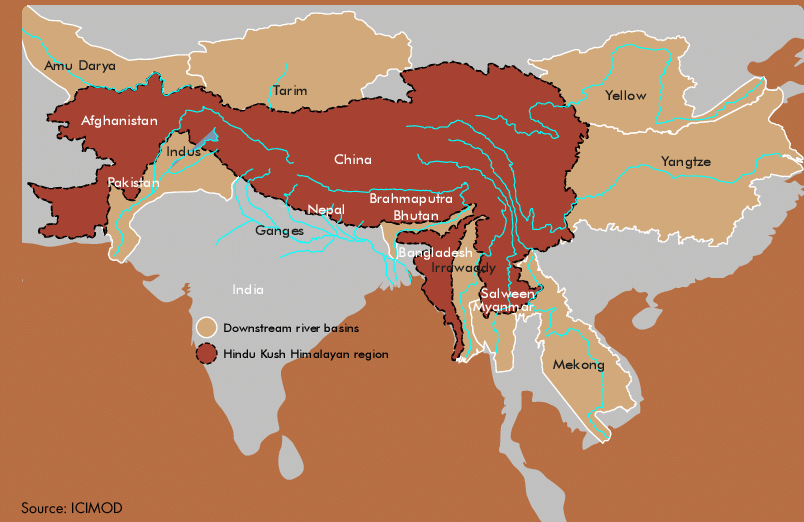Why in news?
The International Centre for Integrated Mountain Development (ICIMOD) recently released the Hindu Kush Himalaya Assessment report.
What is the background?
- The Hindu Kush Himalayan (HKH) region extends 3,500 km over all or part of eight countries from Afghanistan in the west to Myanmar in the east.
- It is the source of ten large Asian river systems – the Amu Darya, Indus, Ganges, Brahmaputra, Irrawaddy, Salween (Nu), Mekong, Yangtse, Yellow River, and Tarim (Dayan).
- It provides water, ecosystem services, and the basis for livelihoods to a population of around 210.53 million people in the region.
- The basins of these rivers provide water to 1.3 billion people, a fifth of the world’s population.
- The Himalayan range alone has the total snow and ice cover of 35,110 sq.km containing 3,735 cu.km of eternal snow and ice.

What does the report reveal?
- It reveals that more than 35 % of the glaciers in the region could retreat by 2100, even if the global temperature rise is capped at 1.5º C.
- This could destabilise the hydrology of large parts of South Asia, China and Myanmar.
- Regions in higher altitudes tend to warm faster than low-lying lands.
- So, a global temperature increase of 1.5ºC could mean at least a 1.8ºC temperature rise in the Hindu Kush Himalayas.
- This will have a major bearing on the ice-fields, which are the largest repository of permafrost outside the polar regions.
- Since the region’s snow is the source of 10 major river systems, large-scale warming could drastically alter the river flows in these countries.
- The receding glaciers could cause a deluge in the rivers during the monsoon while the flows are likely to reduce during the dry seasons, with serious implications for irrigation, hydropower and ecosystem services.
- Also, the receding glaciers might be the reason for the changing monsoon.
- Hindu Kush Himalayan region is a heat sink in summer and a heat source in winter, and this influences the Indian summer monsoon.
- The number of intense precipitation days and intensity of extreme precipitation have increased overall in the last five decades.
- If these trends persist, the frequency and magnitude of water-induced hazards in the Hindu Kush Himalaya region will increase.
- This is a significant conclusion given that developments in the Himalayas are known to have a spin-off on the monsoon in the Subcontinent.
- However, more studies are required to firm up the links between extreme weather events in the higher reaches of the Subcontinent and the erratic weather in the plains.
- For this, more data sharing between the countries that share the Hindu Kush Himalaya is needed.
- Political differences between these countries should not come in the way of joint efforts to build resilience of vulnerable communities and shore up the region’s water security.
- Such cooperation must go alongside meeting the Paris Climate Change Pact’s goals.
What should be done?
- The need is now for informed science-driven advocacy for urgent climate action and immediate conservation efforts.
- Else, the disastrous impact of glacier-melting will leave the world at large reeling.
- Success in meeting the Paris Climate Pact’s target might not be enough to prevent a serious meltdown in the Hindu Kush Himalayas.
- Hence, more realistic targets specific to the region are needed, with the consensus of all the nations surrounding this part of the Himalayan region.
Source: The Indian Express, Financial Express
